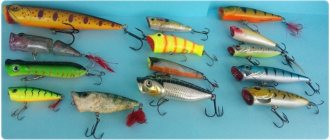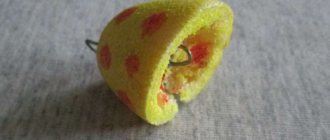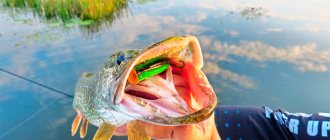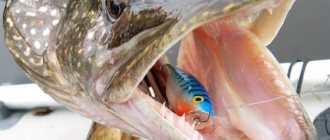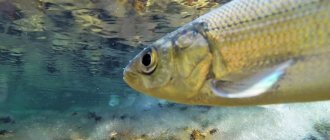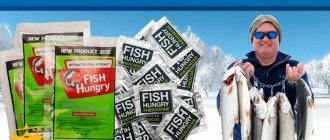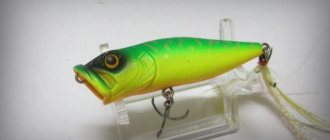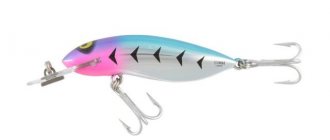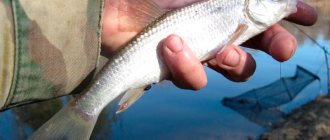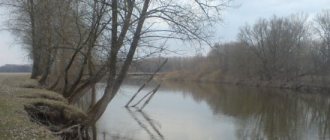Characteristics of poppers
Popper is one of the most popular surface baits of our time. It appeared in America back in the 30s of the last century, although it gained popularity not so long ago - in the 90s. The equipment received its unusual name from the word “squish”, which characterizes its fishing qualities like no other. When wiring, it makes squelching sounds and produces small fountains. If you play the game correctly, then it is difficult to distinguish the equipment from a live fish even for a knowledgeable person, and predators are even more eager to taste it.
This bait should not be confused with an equally popular wobbler. Although they look similar, the popper has a notch on the front and a bevel on the head.
This type of spinning equipment is quite diverse. There are many differences between representatives of the popper model range, but the most important of them is the type of loading. It happens:
– front
– average
– rear
They are also divided into sinking and floating.
The former have the ability to sink to a certain depth, and when jerking, rise to the surface, emitting characteristic sounds. This feature gives the bait even more realism. The latter are suitable for overgrown reservoirs, as they easily pass through thickets and are not afraid of getting caught thanks to special wire antennae.
What is a popper?
A popper is a type of wobbler that looks like a small fish, a frog with an open mouth, or a fairly large insect feeding on the surface. A distinctive feature is the recess in the head part. This design solution of the bait when moving contributes not only to a very loud “gurgling”, but also to splashing water around it. Translated from English, “pop” means “squish” or “gurgle”, hence the name “popper” - gurgling.
The popper was first invented and tested in action more than a hundred years ago in the USA. Popper became widespread, including in our country, in the second half of the last century.
Initially, this type of wobbler was intended as a bait for catching perch, but later it became clear that the popper could be successful for catching other predators.
Popper Accessories
To be successful in popper fishing, it is important to choose the right equipment. First of all, you need to pay attention to the spinning rod. The rod should be light, stiff, short, no more than 2.4 meters, and with a fast action. This will help you make a more accurate cast.
The fishing line is suitable both monofilament and braided. The first one is better to use when using a rod with an ultra-fast action, as it rubs less against the rings, and with a parabolic action, braid is more useful.
The reel must be purchased in sizes from 2000 to 3000 with a gear ratio of at least 1:5 . It should have an instant stop and good line laying. For example, like models with an endless screw. This system will reduce the likelihood of furrows appearing. The selected gear must be of high strength, since popper fishing is aimed at catching large prey, so the arsenal must withstand the foreshadowed struggle.
How to fish with a popper
The technique of wiring a popper is not at all trivial, as it might initially seem. Since it does not have blades, it will not be possible to move the bait evenly.
For a popper, jerk animation or twitching is effective. To make a jerk, just slightly twitch the tip of the rod. Then, during a pause, the slack in the fishing line is pulled out. When retrieving, the main thing is to make the popper make as much noise as possible and splash on the water surface in order to attract the attention of a potential victim.
There are several options for jerk animation used in popper fishing:
- classic animation is suitable for catching active predatory fish. To carry out such wiring, it is necessary to slowly rotate the reel at the same speed and at the same time make jerks of equal amplitude with the rod;
- slow retrieve is effective for a passive predator. It is based on a large number of long pauses and stops;
- chaotic animation is good in the fall. A distinctive feature of chaotic wiring is the sudden movements of the bait. After several amplitude jerks there is a short pause (up to 3 seconds). In the absence of a bite, such an animation can bring results;
- pulsating wiring imitates the movement of a frog. By supporting the rod tip, the popper is given a slight acceleration, after which the reel is reeled in at the same speed. As a result, the bait glides slowly, and then accelerates again after twitching the tip of the spinning rod.
The optimal variation of wiring should be selected experimentally, taking into account the mood of the fish in the fishing area and the temperament of the spinning fisherman. To do this, it is necessary to alternate pauses and their duration, vary the strength, amplitude and frequency of jerks.
Experienced anglers only need a few minutes to determine the optimal fishing technique. When properly animated, the popper makes a seductive, never-ending sound.
What kind of fish can you catch?
The bait, which is very similar to real prey, can easily attract almost any predatory fish. Basically, poppers are aimed at perch, pike and chub. Ide and asp are also not bad, but to catch them you need much more patience than other representatives, because they are very careful. The main thing is to choose the appropriate bait size for each specimen. For example, large models are suitable for pike, and somewhat smaller ones for perch.
What are surface baits and what are they for?
The undoubted advantage of such baits is that they cannot be lost from sight. They are always on the water surface, remaining in sight. Surface baits can be very different in shape, wiring and size.
But all types of such baits have one common property - buoyancy. Some bait models can even overcome grass thickets. This means that when moving, they will not take a whole bunch of algae with them.
Using surface baits, you can catch a predator even in the shallows. After all, it is in the shallows in the summer that schools of small fish feed, which are hunted by large predators.
Tactics and fishing techniques
For a successful fishing outcome, it is not enough to choose suitable and reliable equipment. It is also necessary to develop tactics and choose a fishing technique. In order not to make a mistake in this, you first need to figure out the place, taking into account the lighting, wind direction and the presence of factors such as bushes and trees that may interfere with making a long cast. Of course, each fisherman will have his own selected fishing technique. But it’s best if it’s a classic, effective game with pauses and jerks. Their frequency depends on the selected popper.
To determine whether the wiring is correct, you need to look at what sounds the bait makes when jerking. They should be stable, eye-catching and gurgling. Small fountains of spray should also diverge to the sides.
The game shouldn't be stable, it should be interesting. It is best to experiment with wiring and change equipment periodically. This will attract the attention of even the most suspicious fish.
You can try to catch some representatives of predatory species using a simple uniform retrieve. This tactic is best used in reservoirs with decent depth and abundant vegetation. But you shouldn’t get carried away with such wiring, alternating it with a faster game.
What is the best time to fish?
Experienced fishermen usually use poppers during the open water period, namely from the beginning of spring, when pike live in flooded areas of reservoirs, until the end of November. But the best time to use this profit is still summer and early autumn. This is due to the fact that at this time of year underwater algae begin to bloom, in which small fish like to camouflage, and large predators begin their hunt at shallow depths.
But closer to mid-autumn, the water noticeably clears, and the bright bait is clearly visible on the surface. This increases the likelihood that it will be noticed by a predator, which is diligently eaten off by the winter.
To fish with this type of equipment, it is better to choose calm, windless weather. Of course, light rain and light wind will do little to interfere with fishing, but in windier weather the characteristic squelching sound is hard to hear, and this deprives the popper of its main advantage . It will also be quite difficult to throw a light bait over a long distance.
The best time to use a popper is at the beginning or end of the day. At this time, especially an hour before sunset, predators begin to show themselves most. It will be quite difficult to catch in the dark. The number of bites increases noticeably at sunrise, around three o'clock.
Poppers color
Every fishing enthusiast, especially one who has been engaged in this type of fishing for a long time, has a favorite color of bait that, in his opinion, best attracts the inhabitants of water bodies.
In general, the color of the popper does not play a big role, but if the fisherman has not yet decided which one he prefers, then it is best to choose a bait of a universal color. For example, with an acid green or bright orange-yellow belly. Many spinning anglers believe that the best color is natural, silver-gray, matching the color of the fry’s scales.
Where to fish
Small, overgrown reservoirs with large concentrations of small fish are most suitable for fishing. These resources are great for attracting predators. In calm weather, the popper can be used almost anywhere, since in the absence of waves the popper is clearly visible and plays on the surface.
A good first step is to try fishing from the shore in grassy, shallow areas. If this is not possible and you have to fish far from the shore, you will need a rear-loading popper . This model is easier to cast and submerges 35–40 centimeters .
Models with medium load are convenient to use from the shore, since their weight is evenly distributed throughout their body. This makes long casting difficult. And such a bait sinks only 10 - 15 centimeters . This feature allows them to be used in the most overgrown and impassable places for other baits.
Gear collection
Regardless of whether you are fishing from the shore, wading or from a boat, it is better to give preference to a short spinning rod (maximum length - 2.10 meters). The shorter the rod, the further the light bait flies.
Quite comfortable fishing with a pop-popper is possible with a budget reel of size 1000. It should lay the line evenly, although tangling most often occurs through the fault of the angler himself. You just need to look at the spool after each cast, and then there will be no beards.
What to use, monofilament or braid? Braided cord is preferable as it is stronger. Do not forget that a large rudd does not give up without a fight; it will pull the rig into the reeds and do it quite briskly. A strong braided thread is also necessary in order to withstand the fishing of another predator, as well as to tear the bait out of the grass in case of a snag.
It is better to use a fluorocarbon leash; it is less noticeable in the water.
As for hooks, there are no special requirements for them if there is no carp in the reservoir. Everyone who has tried to catch him at least once in their life knows with what ease he unbends the hooks. If there is a high probability of a bite from this strong fish, the best option would be a forged hook with a short shank. Such a carp can neither break nor bend.
